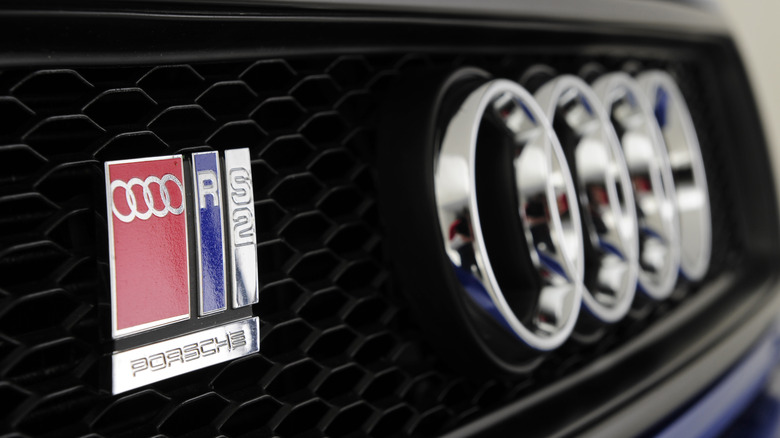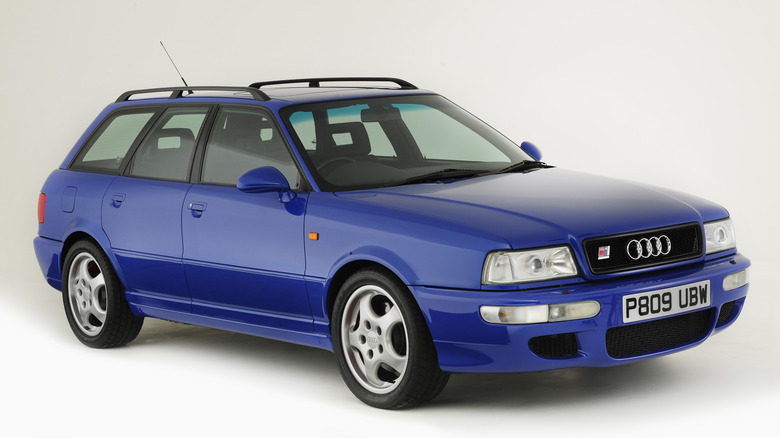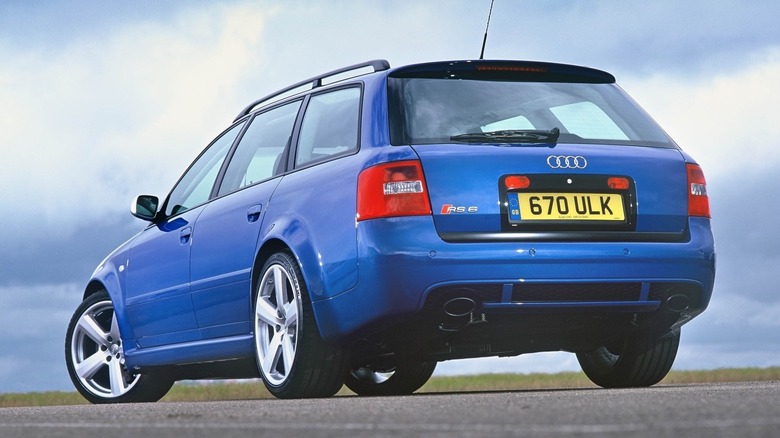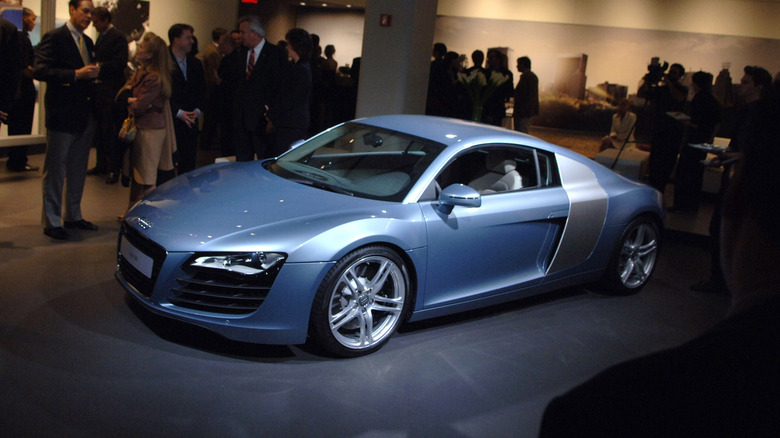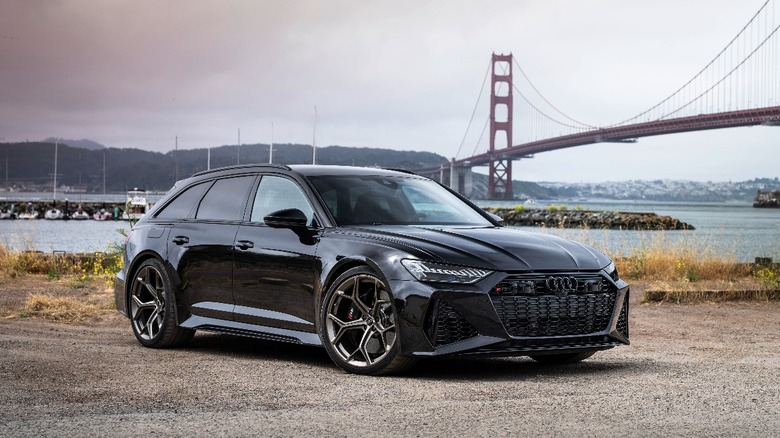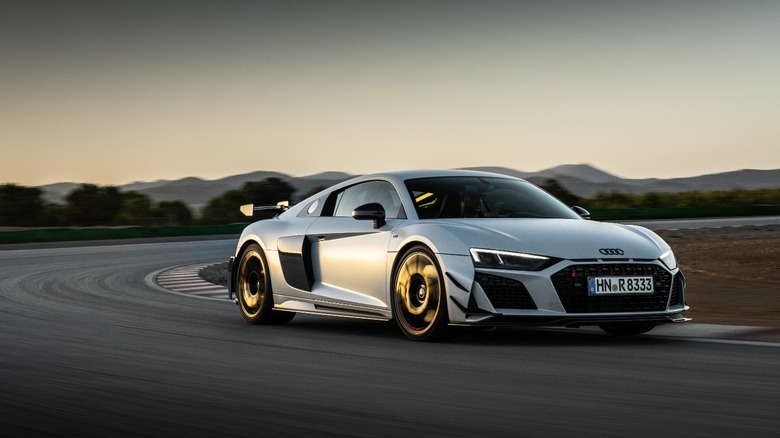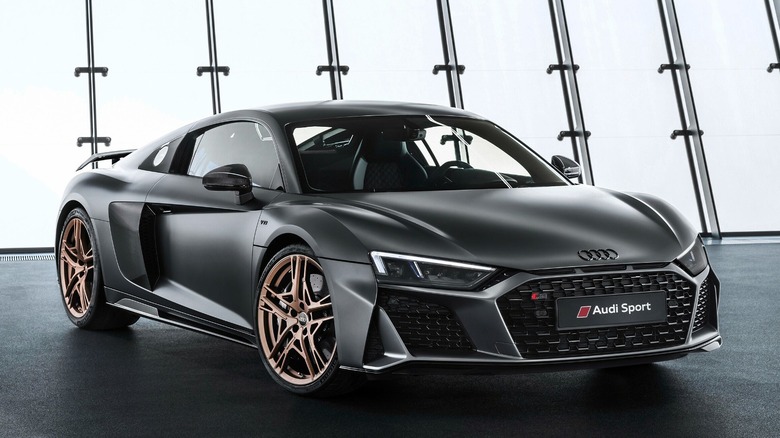5 Of The Fastest Cars Audi Has Ever Made, Ranked By Top Speed
The land between the dense Black Forest and the formidable mountaintops of the Bavarian Alps has spawned some of the best automobiles known to man. Mercedes-Benz, BMW, and Audi have all called southern Germany home since the early 20th century, making it the motherland for luxury and performance enthusiasts alike.
Audi's history is arguably the most complex of the big three upper-mid-tier German sport-luxury brands. Audi's famous four-ring logo hints at its history as a member of the German automaker conglomerate known as Auto Union. While Audi wouldn't gain its individual identity until 1985, Audi models released under the Auto Union brand began making waves in the luxury segment in 1965. Success in the consumer market allowed Audi to pursue other ventures in the late 1970s, with motorsport becoming a major focus. In 1978, the Audi Motorsport division was born, with the four rings quickly becoming synonymous with speed.
To say that Audi Sport was dominant in nearly every motorsport endeavor that it attempted is an understatement. Between 1982 and 1984, the Audi Quattro proved itself to be an unstoppable force and an unforgettable icon in the world of rally racing. In the DTM touring car championship, Audi has toppled entrants from BMW and Mercedes to take eight titles between 1990 and the present day. Audi is the second-winningest team to ever compete in the 24 Hour of Le Mans, winning the world's most prestigious race 13 times between 2000 and 2015. Those accolades don't even paint the full picture.
With so much speed in motorsport, it's no surprise that it carried over to Audi's road cars as well. As the Audi Sport brand has expanded and developed into the consumer market, some of its contributions have become the fastest cars to come out of Germany.
1994 Audi RS2 Avant - 163 MPH
The Audi RS2 Avant was a groundbreaking car when it arrived on the scene in 1994. At the time, hot estates were just beginning to gain a foothold in the market, with the release of the Volvo 850 T5 a year prior proving that it was possible to give the kids whiplash in an estate car. As the first car developed by Audi's Sport division, the RS2 Avant was also the model that made the performance-focused battle a three-horse race between BMW M, Mercedes AMG, and Audi RS.
Starting as a pedestrian Audi 80 station wagon, nearly every important element of the car was given a performance infusion. The most critical revision to the existing Audi 80 was the introduction of one of Audi's beautiful turbocharged inline-five-cylinder engines, which received a full rework by Porsche. Porsche's influence in the RS2 Avant extended well beyond the engine, too, as the brand not only assembled each of the 2,891 RS2s at its Zuffenhausen plant but also used some of its own parts to do so. A number of the RS2's components were taken straight off of Porsche 911 and 968 Clubsport models, including its brakes, side mirrors, and wheels.
As a result of its Porsche-fication, the 2.2-liter five-cylinder received a KKK turbocharger and custom intake manifold, which brought its output to 315 horsepower and 302 lb-ft of torque. The combination of Audi's legendary Quattro all-wheel drive system and a robust power plant made the RS2 Avant the fastest production station wagon in the world at the time, with a top speed of163 miles per hour.
2004 Audi RS6 Avant Plus - 174 MPH
In the ten years following the RS2 Avant's release, hot station wagons became big business for Audi's RS brand. The midsize RS4 Avant was released in 1999 to critical acclaim and the RS6 Avant followed in 2002. Two years after the standard RS6 Avant's release, Audi introduced a special edition version of the wagon, called the RS6 Avant Plus, which turned the dial to 11. It embodied the same supercar-challenging ethos as the earlier RS2, but heaps more power provided by a Cosworth-tuned twin-turbo V8 made it an easier task for the Plus.
Also in a similar vein to the RS2, the RS6 Avant was a true wolf in sheep's clothing. Other than slightly flared bodywork and a puny "RS6" badge adorning its gloss black front grille, the RS6 was nearly indistinguishable from the A6 Avant grocery-getter off of which it was based. Like the standard first-generation RS6 Avant, the RS6 Plus featured a 4.2-liter twin-turbocharged V8 under the hood. The "Plus" title came into play from the model's 30 horsepower bump and its inclusion of a new engine control unit, specialized exhaust system, larger brakes, and improved factory suspension. As a limited edition, only 999 examples were built over a six-month period.
With 480 horsepower and 413 lb-ft of torque available via the go pedal, the RS6 Avant could rocket both the driver and their golf clubs to 60 miles per hour in just 4.3 seconds, making it quicker than the then-current C5 Corvette. Combined with its impressive acceleration, the RS6 Avant Plus' electronically controlled 174 miles per hour top speed made it one of the fastest wagons in the world at the time.
2007 Audi R8 - 187 MPH
The Audi R8 can arguably be considered to be one of the most important "supercars" to come out in the 21st century thus far. If you consider the R8 a supercar, that is. The R8 was unique in the fact that it blurred the lines between the supercar and sports car categories. Unlike any model that Audi had produced prior, the R8 combined a mid-engine layout with its famous Quattro all-wheel drive system, leading to a super-sports car that still upheld the traditional Audi values of luxury, comfort, and usability. Prior to the R8, and outside of the legendary Porsche Carrera GT, there weren't any major mid-engine German threats to the Italian supercar dynasties during the 2000s. As a result, Audi was punching up a weight class on its first attempt.
The key to Audi's success with the R8 was the German brand's acquisition of Lamborghini in 1998. The R8's underpinnings were similar to the less polished Lamborghini Gallardo which launched in 2003. While the R8 would famously receive the Gallardo's 518 horsepower V10 engine for the 2009 model year, the initial car was powered by an Audi-developed, naturally aspirated 4.2-liter V8. Even lacking two cylinders compared to the later car, the V8 was plenty capable, supplying all four wheels with 420 horsepower and 317 lb-ft of torque. That put the R8 in the same bracket as the 997 Porsche 911 and Aston Martin V8 Vantage.While the R8's supercar status might be debated, it certainly had the top speed of one. The 2007 Audi R8 was capable of 187 miles per hour.
2025 Audi RS6 Avant Performance - 190 MPH
Now more than ever, luxury car brands have adopted the fast-wagon formula that Audi helped to pioneer. Mercedes had the supercharged AMG E63 S Wagon in 2023, Porsche offers the Panamera Turbo S Sport Turismo currently, and BMW has its upcoming BMW M5 Touring. Despite the crowd, the RS6 is still a very strong contender. By now, the RS6 line is robust and fully fleshed out, with four distinct generations wearing the badge. As with the previous generations, the 2025 RS6 Avant Performance is a model full of contradictions. Operating on logic alone, no big-bodied estate car should have a 621 horsepower, 625 lb-ft, 4.0-liter twin-turbo V8 under the hood, but that didn't stop Audi from going all-out. Thank goodness for that.
Outside of the RS6 Avant's herculean power plant, it also features a number of impressive features that are typically only reserved for dedicated performance cars. As always, all of the 2025 RS6's power is delivered through a Quattro all-wheel drive system but, unlike previous generations, it features four-wheel steering as well. Standard adaptive suspension also improved the Avant's handling, allowing it to carve corners like a dedicated track weapon, all while providing best-in-class storage and legroom.
Perhaps more than ever, the 2025 RS6 Avant wears its performance chops on its sleeve. Its lowered ride height made it an imposing presence on the road and when coupled with its exceptionally wide stance and massive sport wheels, it throws modest appearances to the wayside. For the first time, the RS6 Avant actually looks as fast as it is, topping out at 190 miles per hour when fitted with carbon ceramic brakes.
2023 Audi R8 GT - 199 MPH
Just as the 2006 Audi R8 arrived on the scene with a huge bang, the model went out with one as well. 2023 was the final model year that Audi offered the vaunted R8 and in doing so, made sure that it would stick in the memory of fans for decades to come. That year, the final edition R8 GT was released with some major upgrades that made it one of the most potent R8 models ever created. As with the non-special edition cars, the R8 GT featured a mid-mounted 5.2-liter V10, albeit with a tablespoon more horsepower.
The second generation V10 Audi R8 was available in both rear- and all-wheel drive trims, with the latter being the one to get if you wanted the high-horsepower engine option. While Quattro all-wheel drive is a staple of not only the Audi brand but also the R8 itself, many close-minded enthusiasts don't see it as a viable option for track-focused antics. As a track-focused special edition, the R8 GT featured the best of both worlds, combining the most powerful 602 horsepower V10 offered in any R8 with rear-wheel drive. To help manage the extra power, the R8 GT featured an upgraded stability control system. It looked the part too, receiving a number of hardcore cosmetic upgrades that served an aerodynamic purpose, including a carbon-fiber front splitter, side spats, rear scoops, a diffuser, and a bulging rear wing.
With only 333 Audi R8 GTs sold worldwide, the R8's final goodbye was a luxury that only a few could enjoy. Those lucky few were privy to one of the fastest Audis ever made, as the R8 GT could reach a top speed of 199 miles per hour.
2020 Audi R8 Decennium - 205.7 MPH
A decade is a long time for anything, but it's an especially long time for the lifecycle of an automobile. While the Audi R8 debuted in 2007 with a V8 under the hood, it was the V10 model, which was released two years later, that truly set the tone for the remainder of the model's working life. To commemorate the ten-year anniversary of the Lamborghini-sourced 10-cylinder appearing under the hinged-glass vanity cover behind the R8's cockpit, Audi released the R8 Decennium — arguably the fastest factory Audi ever made in terms of top speed.
Over the course of the standard R8 V10's production, it evolved and became increasingly more muscular. Initially, it was released in a standard output variant with 518 German horses in the stable. Following a mid-cycle refresh of the first-generation R8 in 2012, the R8 got a major performance overhaul two years later. In "Plus" trim, the R8 entered a new class. With 542 horsepower and 398 lb-ft of torque on tap, the R8 V10 Plus could brawl with Italian heavyweights. The Plus evolved into an even more potent threat in the years to come, eventually peaking with 602 horsepower under a new "Performance" trim name in 2019. Unsurprisingly, the Decennium was based on the most powerful Performance variant, albeit with another 18 horses added on top.
Outside of the Decennium's 620 horsepower output, its flair was entirely aesthetic, featuring one-off Mythos Black paint, blacked-out badges and accessories, 20-inch bronze wheels, and a bronze valve cover. While the Decennium wasn't mechanically special, its 205.7 MPH top speed slightly edges out the V10 Performance's top speed while also celebrating the legacy of the ten-cylinder unit that made the speed possible in the first place.
